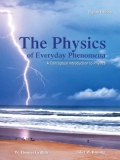
(a)
The mass per unit length of the rope.
(a)
Answer to Problem 1SP
The mass per unit length of the rope is
Explanation of Solution
Given info: The length of the rope is
Write the equation to find the mass per unit length of the rope.
Here,
Substitute
Conclusion:
Therefore, the mass per unit length of the rope is
(b)
The speed of the waves formed in the rope.
(b)
Answer to Problem 1SP
The speed of the waves formed in the rope is
Explanation of Solution
Given info: The tension in the rope is
Write the equation to find the velocity of waves formed in a rope under tension.
Here,
Substitute
Conclusion:
Therefore, the velocity of the waves formed in the rope is
(c)
The wavelength of the waves formed in the rope.
(c)
Answer to Problem 1SP
The wavelength of the waves formed in the rope is
Explanation of Solution
Given info: Frequency of the waves in the rope is
Write the equation to find the wavelength of the waves formed in the rope.
Here,
Substitute
Conclusion:
Therefore, the wavelength of the wave formed in the rope is
(d)
The number of complete cycles of wave that will fit on the rope.
(d)
Answer to Problem 1SP
The number of complete cycles of waves that is formed in the rope is
Explanation of Solution
The length of rope used is
Therefore the number of wave cycles that will be completed in the rope is found by just dividing the total length by wavelength.
Write the equation to find the number of wave cycles completed.
Here,
Substitute
Conclusion:
Therefore, the number of wave cycles in the rope is
(e)
The time taken by the leading edge of the waves to go and come back from the edge of the rope.
(e)
Answer to Problem 1SP
The waves take a time of
Explanation of Solution
The waves need to travel a distance of
The time taken by a wave to complete one cycle of motion is called time period. We have two cycles here and so we have to multiply the time period for one cycle by two to get the time period for two cycles.
Write the equation to find the time period of two cycles of waves.
Here,
Substitute
Conclusion:
Therefore, the time taken by the waves to reach and start back again from the end of the rope is
Want to see more full solutions like this?
Chapter 15 Solutions
EBK PHYSICS OF EVERYDAY PHENOMENA
- answer the question symbolically until you have to plug in numbers. show all work please.arrow_forwardWhat is the direction of the magnetic force on a NEGATIVE CHARGE that moves as shown in each of the six cases?arrow_forwardHi! I need help with these calculations for part i and part k for a physics Diffraction Lab. We used a slit width 0.4 mm to measure our pattern.arrow_forward
- Examine the data and % error values in Data Table 3 where the angular displacement of the simple pendulum decreased but the mass of the pendulum bob and the length of the pendulum remained constant. Describe whether or not your data shows that the period of the pendulum depends on the angular displacement of the pendulum bob, to within a reasonable percent error.arrow_forwardIn addition to the anyalysis of the graph, show mathematically that the slope of that line is 2π/√g . Using the slope of your line calculate the value of g and compare it to 9.8.arrow_forwardAn object is placed 24.1 cm to the left of a diverging lens (f = -6.51 cm). A concave mirror (f= 14.8 cm) is placed 30.2 cm to the right of the lens to form an image of the first image formed by the lens. Find the final image distance, measured relative to the mirror. (b) Is the final image real or virtual? (c) Is the final image upright or inverted with respect to the original object?arrow_forward
- Concept Simulation 26.4 provides the option of exploring the ray diagram that applies to this problem. The distance between an object and its image formed by a diverging lens is 5.90 cm. The focal length of the lens is -2.60 cm. Find (a) the image distance and (b) the object distance.arrow_forwardPls help ASAParrow_forwardPls help ASAParrow_forward
 College PhysicsPhysicsISBN:9781305952300Author:Raymond A. Serway, Chris VuillePublisher:Cengage Learning
College PhysicsPhysicsISBN:9781305952300Author:Raymond A. Serway, Chris VuillePublisher:Cengage Learning University Physics (14th Edition)PhysicsISBN:9780133969290Author:Hugh D. Young, Roger A. FreedmanPublisher:PEARSON
University Physics (14th Edition)PhysicsISBN:9780133969290Author:Hugh D. Young, Roger A. FreedmanPublisher:PEARSON Introduction To Quantum MechanicsPhysicsISBN:9781107189638Author:Griffiths, David J., Schroeter, Darrell F.Publisher:Cambridge University Press
Introduction To Quantum MechanicsPhysicsISBN:9781107189638Author:Griffiths, David J., Schroeter, Darrell F.Publisher:Cambridge University Press Physics for Scientists and EngineersPhysicsISBN:9781337553278Author:Raymond A. Serway, John W. JewettPublisher:Cengage Learning
Physics for Scientists and EngineersPhysicsISBN:9781337553278Author:Raymond A. Serway, John W. JewettPublisher:Cengage Learning Lecture- Tutorials for Introductory AstronomyPhysicsISBN:9780321820464Author:Edward E. Prather, Tim P. Slater, Jeff P. Adams, Gina BrissendenPublisher:Addison-Wesley
Lecture- Tutorials for Introductory AstronomyPhysicsISBN:9780321820464Author:Edward E. Prather, Tim P. Slater, Jeff P. Adams, Gina BrissendenPublisher:Addison-Wesley College Physics: A Strategic Approach (4th Editio...PhysicsISBN:9780134609034Author:Randall D. Knight (Professor Emeritus), Brian Jones, Stuart FieldPublisher:PEARSON
College Physics: A Strategic Approach (4th Editio...PhysicsISBN:9780134609034Author:Randall D. Knight (Professor Emeritus), Brian Jones, Stuart FieldPublisher:PEARSON





